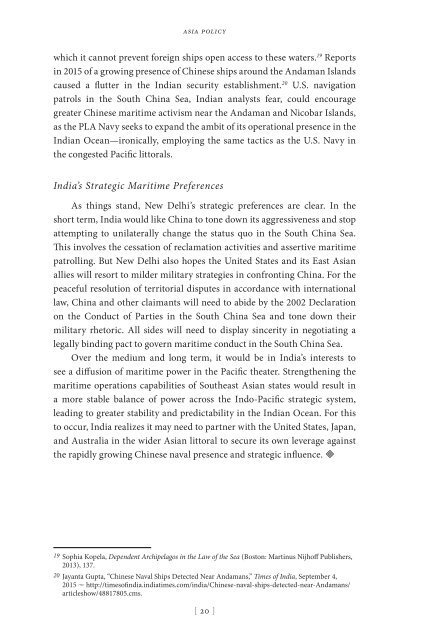Create successful ePaper yourself
Turn your PDF publications into a flip-book with our unique Google optimized e-Paper software.
asia policy<br />
which it cannot prevent foreign ships open access to these waters. 19 Reports<br />
in 2015 of a growing presence of Chinese ships around the Andaman Islands<br />
caused a flutter in the Indian security establishment. 20 U.S. navigation<br />
patrols in the South China Sea, Indian analysts fear, could encourage<br />
greater Chinese maritime activism near the Andaman and Nicobar Islands,<br />
as the PLA Navy seeks to expand the ambit of its operational presence in the<br />
Indian Ocean—ironically, employing the same tactics as the U.S. Navy in<br />
the congested Pacific littorals.<br />
India’s Strategic Maritime Preferences<br />
As things stand, New Delhi’s strategic preferences are clear. In the<br />
short term, India would like China to tone down its aggressiveness and stop<br />
attempting to unilaterally change the status quo in the South China Sea.<br />
This involves the cessation of reclamation activities and assertive maritime<br />
patrolling. But New Delhi also hopes the United States and its East Asian<br />
allies will resort to milder military strategies in confronting China. For the<br />
peaceful resolution of territorial disputes in accordance with international<br />
law, China and other claimants will need to abide by the 2002 Declaration<br />
on the Conduct of Parties in the South China Sea and tone down their<br />
military rhetoric. All sides will need to display sincerity in negotiating a<br />
legally binding pact to govern maritime conduct in the South China Sea.<br />
Over the medium and long term, it would be in India’s interests to<br />
see a diffusion of maritime power in the Pacific theater. Strengthening the<br />
maritime operations capabilities of Southeast Asian states would result in<br />
a more stable balance of power across the Indo-Pacific strategic system,<br />
leading to greater stability and predictability in the Indian Ocean. For this<br />
to occur, India realizes it may need to partner with the United States, Japan,<br />
and Australia in the wider Asian littoral to secure its own leverage against<br />
the rapidly growing Chinese naval presence and strategic influence. <br />
19 Sophia Kopela, Dependent Archipelagos in the Law of the Sea (Boston: Martinus Nijhoff Publishers,<br />
2013), 137.<br />
20 Jayanta Gupta, “Chinese Naval Ships Detected Near Andamans,” Times of India, September 4,<br />
2015 u http://timesofindia.indiatimes.com/india/Chinese-naval-ships-detected-near-Andamans/<br />
articleshow/48817805.cms.<br />
[ 20 ]


